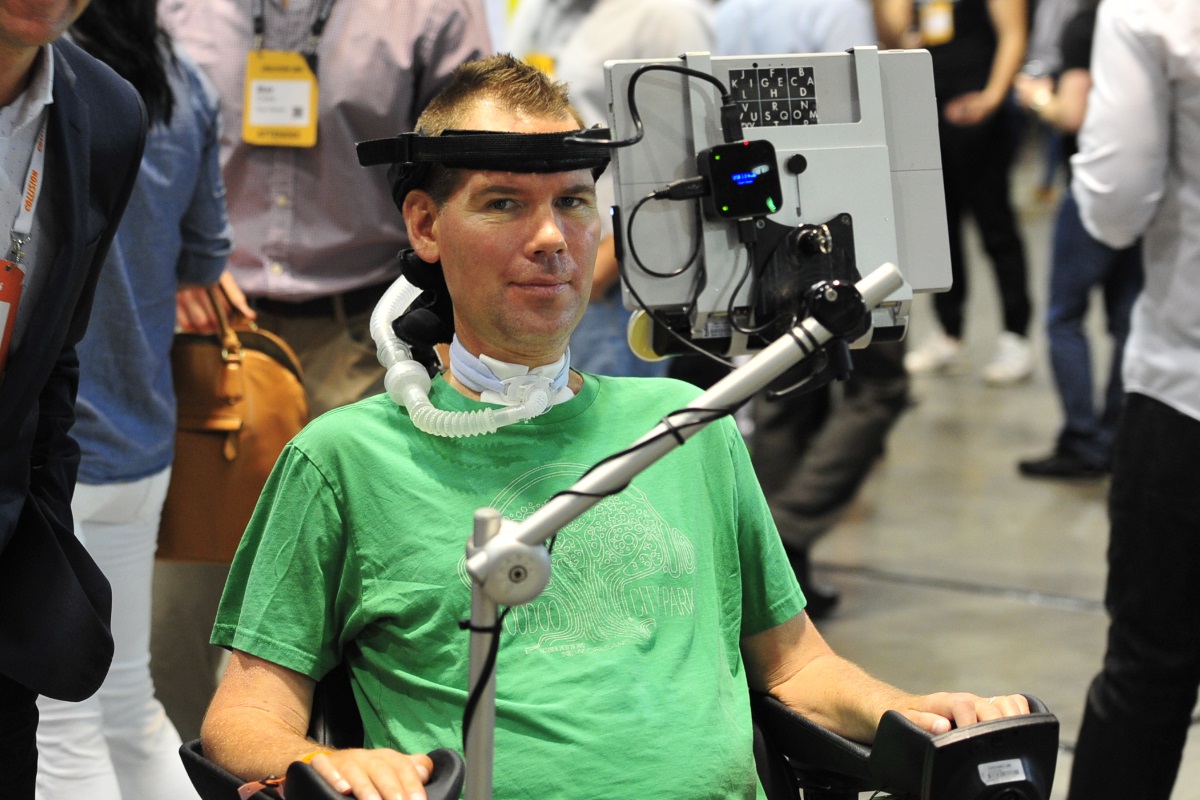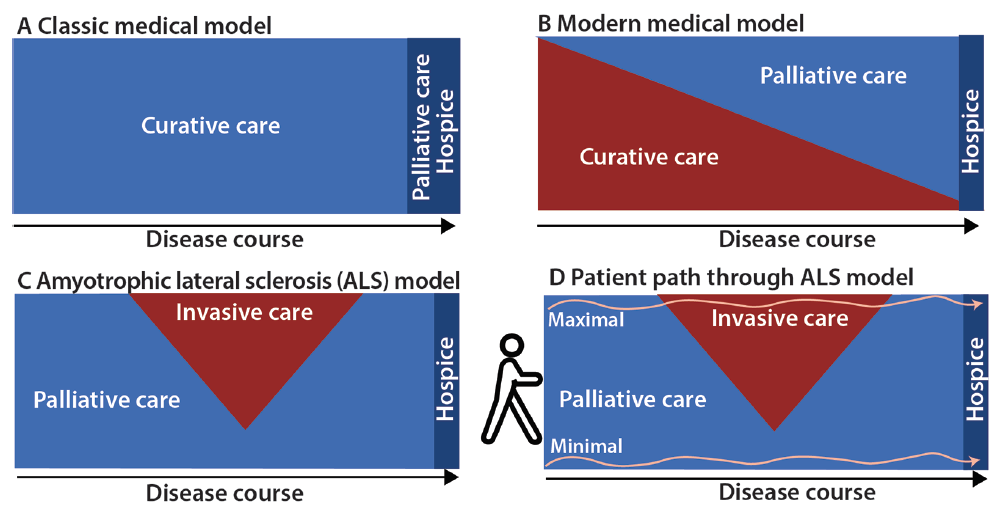Access the Provider Directory. Lou Gehrigs disease also known as amyotrophic lateral sclerosis ALS is a progressive neurodegenerative disorder that affects the muscles in the body and leads to complete paralysis and possibly death.

Read One Couple S Journey Related To Finding Home Care For Brian Who Has Als An Acute Long Term Illness Home Care Home Health Care Anticipatory Grief
However loved ones who see the following symptoms can be fairly sure that the ALS has progressed to a point where all involved would likely benefit from hospice services.

. It is often called Lou Gehrigs Disease It is a progressive disease where voluntary muscle action is affected. Exercise Physical Therapy 3. This disease is characterized by the progressive death of the motor neurons.
Emotional Support Including For Caregivers 6. ALS is the most common form of motor neuron disease and the third most common neurodegenerative disorder behind Alzheimer disease and Parkinson disease. Palliative Care involves a team of professionals who work together to nurture individual choices and to treat symptoms.
Palliative care can help you keep as much control as possible supporting you and your family to maintain your quality of life. Who can benefit from palliative and supportive care. And control over your life.
Is it Right for You. Here are some of the lifestyle changes your elderly loved one can make to decrease the odds of developing ALS. Muscle Weakness Muscle Cramps Muscle Stiffness Dysarthria Difficulty Speaking Slurred Speech Dysphagia Difficulty Swallowing Dyspnea Breathing Difficulties Incontinence.
Lou Gehrigs Disease. Sleep Rest Precautions Regarding Lou Gehrigs Disease Key Points About Lou Gehrigs Disease. ALS Lou Gehrigs Disease Amyotrophic lateral sclerosis ALS also called Lou Gehrigs disease is a nervous system disease that attacks nerve cells called neurons in your brain and spinal cord.
Elderly and Seniors with Amyotrophic Lateral Sclerosis ALS also known as Lou Gehrigs Disease display the following progressive symptoms due to nerve and muscle atrophy. Only a doctor can make a clinical determination of the life expectancy of a patient with ALS also known as Lou Gehrigs disease. Constant reinforcement of all of the many things that need to be learned from.
Treatment focuses on slowing the progression of symptoms preserving and maintaining mobility function and nutrition and preventing unnecessary complications. Key Points About Lou Gehrigs Disease Amyotrophic lateral sclerosis ALS or Lou Gehrigs disease is a rapidly progressive degenerative neuromuscular disease that affects motor neurons. Handout for Patients and Families.
The patient has become wheelchair- or bed-bound. She lives alone and works at the local library. Facilitating and enhancing a persons quality of lifeThe distinction that massage therapy has in this venue is that it employs.
Eat A Nutrient-Dense Diet 2. The disease is progressive meaning the symptoms get worse over time. When they die movement and cognition are impaired x.
Amyotrophic Lateral Sclerosis and Palliative Care ALS amyotrophic lateral sclerosisis a disease that causes nerve cells in parts of the brain and spinal cord to die. Lou Gehrigs disease also known as amyotrophic lateral sclerosis ALS is a rare neurological disease that affects the muscular system by killing nerve cells. Lou Gehrigs Disease Prognosis.
The muscles become atrophied and paralyzed. This self-instructional program examines the pathology signs and symptoms research treatment and support approaches for a patient with amyotrophic lateral sclerosis or Lou Gehrigs disease. There is no cure for Lou Gehrigs disease.
6 Natural Ways to Help Manage ALS Symptoms 1. Palliative Care refers to supportive and comforting care versus healthcare that is designed to treat a particular disease process. Consume Omega-3 Fatty Acids.
Although Lou Gehrigs disease cant be cured yet medications can help treat the symptoms and. Other such conditions include Parkinsons Muscular Dystrophy Myasthenia Gravis or Multiple Sclerosis. Signs and symptoms of Lou Gehrigs disease include weakness in the arms and legs slurred speech muscle atrophy loss of balance pain muscle twitching and poor posture.
2 An estimated 300000 individuals are living with ALS in the US currently. Hospice Care and Support Services for Patients Suffering from Lou Gehrigs Disease ALS ALS is one of several chronic degenerative conditions. The not-for-profit voice for advanced illness hospice and palliative care.
The disease got its name from Lou Gehrig the famous baseball player for the New York Yankees who died from ALS at the age of 38 although typically the disease strikes at people who are over the age of 50. The most common form of motor neuron disease known simply as motor neurone disease or amyotrophic lateral sclerosis or Lou Gehrigs disease is usually not inherited and its cause remains unknown. People living with cancer congestive heart failure Lou Gehrigs disease ALS Alzheimers disease and other life-threatening conditions.
Lou Gehrigs disease also known as amyotrophic lateral sclerosis ALS is a rare neurological disease that affects the muscular system by killing nerve cells. 3 The median age of onset is 55 and disease incidence peaks between ages 70 and 75. 14 More males are affected than females.
Lou Gehrigs disease continues to be the popular eponym for amyotrophic lateral sclerosis The article offers lots of insight into Gehrigs experience at The Mayo Clinic. These cells are responsible for sending messages in the nervous system. The disease is progressive and the symptoms get worse over time.

Fairview Resident Nell Hardy Will Take Part In The Walk To Defeat Als Sponsored By The Greater New York Chapter Of The Al Nerve Cell Brain Nerves Motor Neuron

New Tools For Patients With Als

Als And Palliative Care Medical Minute Youtube

Advance Care Planning In Amyotrophic Lateral Sclerosis Practical Neurology

Advance Care Planning In Amyotrophic Lateral Sclerosis Practical Neurology

Patient Care Fairhope Hospice And Palliative Care

Do Als Patients Qualify For Hospice Lower Cape Fear Lifecare

0 comments
Post a Comment